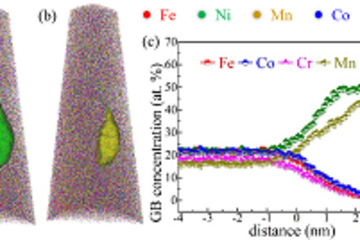All genres
901.
Journal Article
Texture component crystal plasticity finite element method for physically-based metal forming simulations including texture update. Proc. 8th Int. Conf. on Aluminium Alloys, pp. 31 - 36 (2002)
902.
Journal Article
Surface micromechanics of polymer coated aluminium sheets during plastic deformation. Advanced Engineering Materials 4, pp. 859 - 864 (2002)
903.
Journal Article
On the dependence of in-grain subdivision and deformation texture of aluminium on grain interaction. Acta Materialia 50, pp. 4379 - 4394 (2002)
904.
Journal Article
Theory of orientation gradients. (Proc. ICOTOM 13), pp. 275 - 280 (2002)
905.
Journal Article
Experimental investigation of plastic grain interaction. Materials Science and Engineering A 336, pp. 81 - 87 (2002)
906.
Journal Article
Influence of grain neighborhood on FCC texture simulation. Proc. ICOTOM 13, pp. 281 - 286 (2002)
907.
Journal Article
Micromechanical and macromechanical effects in grain scale polycrystal plasticity experimentation and simulation. Acta Materialia 49 (17), pp. 3433 - 3441 (2001)
908.
Journal Article
Optimizing continuous annealing of IF steels for improving their deep drawability. Metallurgical and Materials Transactions A 32, pp. 1989 - 1995 (2001)
909.
Journal Article
A hybrid model for mesoscopic simulation of recrystallization. Computational Materials Science 21, pp. 69 - 78 (2001)
910.
Journal Article
Introduction of a texture component crystal plasticity finite element method for anisotropy simulations. Advanced Engineering Materials 3, pp. 984 - 990 (2001)
911.
Journal Article
Work hardening in heterogeneous alloys - A microstructural approach based on three internal state variables. Acta Materialia 48 (17), pp. 4181 - 4189 (2000)
912.
Journal Article
Yield surface simulation for partially recrystallized aluminium polycrystals on the basis of spatially discrete data. Computational Materials Science 19, pp. 13 - 26 (2000)
913.
Journal Article
Coupling of a crystal plasticity finite element model with a probabilistic cellular automaton for simulating primary static recrystallization in aluminum. Modelling and Simulation in Materials Science and Engineering 8, pp. 445 - 462 (2000)
914.
Journal Article
Processing, microstructure, and properties of ternary high-strength Cu–Cr–Ag in situ composites. Material Science and Engineering A 291, pp. 186 - 197 (2000)
915.
Journal Article
Experimental investigation and Ginzburg-Landau modeling of the microstructure dependence of superconductivity in Cu–Ag–Nb wires. Acta Materialia 47 (3), pp. 769 - 777 (1999)
916.
Journal Article
Experimental investigation and modeling of the influence of microstructure on the resistive conductivity of a Cu–Ag–Nb in situ composite. Acta Materialia 47, pp. 1627 - 1634 (1999)
917.
Journal Article
Simulation of the texture evolution during annealing of cold rolled BCC and FCC matals using a cellular automation approach. Textures and Microstructures 28, pp. 211 - 218 (1997)
918.
Journal Article
Strip casting of stainless steels. Acta Materialia 45, pp. 1137 - 1151 (1997)
919.
Journal Article
Texture simulation for hot rolling of aluminium by use of a Taylor model considering grain interactions. Acta Metallurgica et Materialia 43 (3), pp. 1023 - 1028 (1995)
920.
Journal Article
Rolling and recrystallization textures of bcc steels. Steel Research 62 (12), pp. 567 - 575 (1991)











